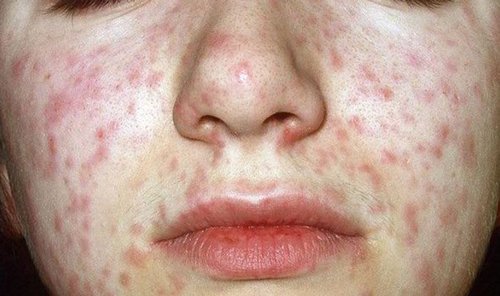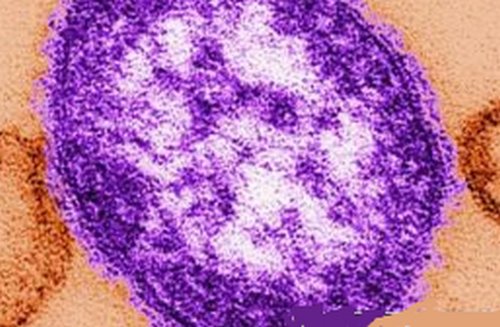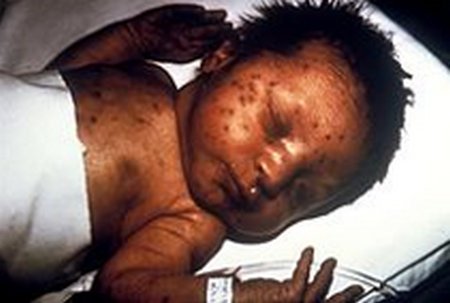Viral Exanthem
The name viral exanthem originates from the Greek word “exanthema” which means breaking out. This is a viral rash that pops up suddenly and spreads throughout the body.
It is a self-limited infection. This means that there are minimal chances of the disease affecting any other person in contact with the patient.
This infection is mostly found in children. The table below shows classification of viral exanthems.

Figure 1 : Types of viral exanthem
Image Source : image.slidesharecdn.com
Types of Viral Exanthem
1. Measles (Rubeola)

Picture 2 : Measles
Image Source : www.express.co.uk
Characteristics
- Causative agent is rubeola virus.
- It is only found in human beings especially children.
- Incubation period is less than seven days.
- It is highly contagious. The patient can affect another even before all the symptoms start to show.
- The virus first starts by attacking the respiratory epithelium and later spreads to other body parts through blood.
Symptoms
- It starts with very high fever accompanied by coughing and discharge of mucus.
- Spots start spreading from the nose to the forehead and later to other parts of the body.
Treatment
There is no treatment for measles. The symptoms usually disappear within 2-3 weeks. However, one can do as stated below to help ease the symptoms.
- Muscle aches and fever can be reduced using acetaminophen
- Rest will help boost a person’s immunity
- Lots of fluids are recommended – 6 to 8 glasses of water daily
- Vitamin A supplements
- A humidifier will help ease sore throat and cough
Prevention - Measles can be prevented through vaccination where the patient is administered with measles vaccine together with mumps and rubella vaccine. The name given to this vaccine is MMR. Doctors usually vaccinate children of between 12 to 15 months of age and later 4 to 6 years of age.
- If the child is already infected the physician is supposed to vaccinate the child within 72 hours to prevent the disease from spreading even further.
- Infected children should not report to school in order to prevent the disease from spreading.
- The person handling the infected child should be properly immunized.

Image 3 : Measles under microscopic view
Photo Source : www.pcds.org.uk
2. Rubella (German measles)
Characteristics
- The causative agent is rubella virus.
- This virus incubates for approximately 2-3 weeks.
- Rubella is spread by direct contact with the patient.
- It can be contagious within the first seven days of infection.
- The rash first starts on the forehead then spreads out to other parts the body
- A pregnant mother can spread the virus to the unborn baby especially through fluids.
Symptoms
- Infected child may experience high fever.
- Pink rashes appear on the infected child.
- Enlargement of nymph nodes.
- In adolescent children, soreness and irritations can be experienced [4]
Prevention
This can be prevented using the MMR vaccine.
Treatment
This also has no specific treatment and disappears within 7-10 days. Symptoms can be treated through controlling fever, relieving pain, drinking plenty of fluids, managing sore throats, relieving cough and drinking warm drinks.
3. Congenital Rubella
This occurs in infants whose mothers are infected with the rubella virus.
When the rubella virus present in a mother affects their developing baby, it results in congenital rubella. The word congenital defines something that is present when a baby is born. Rubella in this case affects the baby during the first trimester of pregnancy.
Due to the rubella vaccine, the number of babies born with rubella has decreased.
Symptoms
- The patient can experience heart problems
- Eye defects such as clouded cornea can be evident.
- Patient can become mentally retarded.
- Bone marrow illnesses
- Low birth weight in children[4]
- Deafness
- A rash on the skin at birth
- Seizures
- Irritability
- Small size of the baby’s head
- Delays in developmental milestones
- Excessive sleepiness
Diagnosis
Blood and urine tests are conducted to detect the rubella virus.
Treatment
There is no definite treatment for this disease since its causative agent is a virus, therefore symptoms are treated as necessary.

Picture 4 : A child with rashes from congenital rubella
Photo Source : upload.wikimedia.org
Prevention
A mother can get vaccinated before pregnancy to prevent congenital rubella. Expectant mothers who have not been vaccinated should avoid being in contact with anyone who has the rubella virus.
4. Roseola
Characteristics
This disease is caused by the Human Herpes Virus 6 (HHV-6) or Human Herpes Virus 7 (HHV-7). It mostly affects children aged between 6 and 24 months. Incubation takes 5-15 days before the disease starts to manifest itself. At this time children are highly contagious. [1, 5]
Symptoms
- Irritability
- Swollen glands at the neck (back or front)
- Mild diarrhea
- High fever develops which lasts for around 3-4 days
- Swelling of eyelids
- Rash that starts on the trunk then spreads to the neck, arms and legs
Diagnosis - The clinical pattern of a quick onset of high fever followed by the development of the characteristic roseola rash as the fever reduces quickly enables doctors to diagnose without necessarily doing any laboratory tests [6]
- Doctors may inform the parents to look out for the rash as the fever is treated at home
- Blood tests can be done to detect antibodies to roseola
Treatment - There is no specific treatment but symptoms can be managed
- Most children fully recover 7 days from the onset of fever
- Over-the-counter medications such as acetaminophen and ibuprofen can be used to reduce fever
- Ganciclovir, an antiviral medication, may be prescribed by some doctors for people who have weakened immunity.

Image 5 : Coverage of Roseola on the child’s body
Picture Source : img.webmd.boots.com
References :
- Koonin EV, Senkevich TG, Dolja VV. The ancient Virus World and evolution of cells. Biol. Direct. 2006;1:29. doi:10.1186/1745-6150-1-29. PMID 1698464
- Bialecki C, Feder HM, Grant-Kels JM (November 1989). “The six classic childhood exanthems: a review and update”. J Am Acad Dermatol. 21 (5 Pt 1): 891–903. PMID 2681288
- “fifth disease” at Dorland’s Medical Dictionary
- Atkinson, William (2011). Epidemiology and Prevention of Vaccine-Preventable Diseases (12 ed.). Public Health Foundation. pp. 301–323. ISBN 9780983263135. Retrieved Mar 2015.
- Zerr DM, Meier AS, Selke SS, et al. (February 2005). “A population-based study of primary human herpesvirus 6 infection”. N. Engl. J. Med. 352 (8): 768–76. doi:10.1056/NEJMoa042207
- http://www.nlm.nih.gov/medlineplus/ency/article/000968.htm
- Cherry J. Roseola Infantum (Exanthem Subitum). In: Cherry J, Harrison GJ, Kaplan SL, Steinbach WJ, Hotez PJ, eds. Feigin and Cherry’s Textbook of Pediatric Infectious Diseases. 7th ed. Philadelphia, PA: Elsevier Saunders; 2014:chap 59.
- Caserta MT. Roseola (Human Herpes Viruses 6 and 7). In: Kliegman RM, Stanton BF, St Geme JW, Schor NF, eds. Nelson Textbook of Pediatrics. 20th ed. Philadelphia, PA: Elsevier; 2016:chap 256
- http://www.hhv-6foundation.org/
- http://childrensnational.org/sitemap